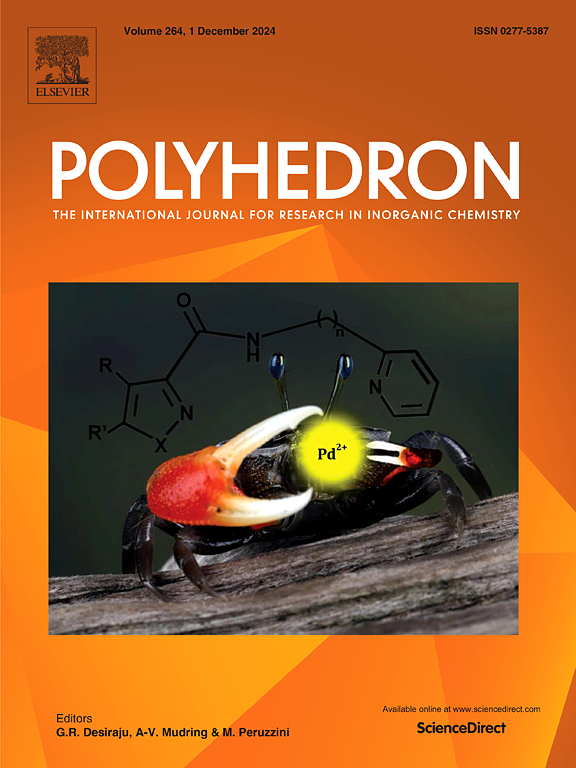Phenolato and alkoxo promoted change in the ligand coordination mode in a four-membered ortho-metalated ruthenium(II) organometallics
IF 2.4
3区 化学
Q2 CHEMISTRY, INORGANIC & NUCLEAR
引用次数: 0
Abstract
The reaction of Ru(κ2C,O-RL)(PPh3)2(CO)(Cl) [κ2C,O-RL is C6H2O-2-CHNHC6H4R(p)-3-Me-5 and R = Me, OMe, Cl] with excess sodium p-methylphenolate (p-MeC6H4ONa) or sodium methoxide (MeONa) in dichloromethane–methanol medium afforded the paramagnetic binuclear ruthenium(III) complexes of the type [Ru(µ:κ3C,N,O-RL)(PPh3)(CO)(OR′)]2 [κ3C,N,O-RL is C6H2O-2-CHNC6H4R(p)-3-Me-5] in moderate yield. Three different R and two different R′ groups have been used in this study: R = Me and R′ is p-MeC6H4, 2(Me); R = OMe and R′ is p-MeC6H4, 2(OMe); R = Cl and R′ is p-MeC6H4, 2(Cl); R and R′ = Me, 3. The binding of the phenolato/alkoxo ligand is attended with the cleavage of the Ru![]() C(aryl), Ru
C(aryl), Ru![]() Cl and one of the Ru
Cl and one of the Ru![]() P bonds in Ru(κ2C,O-RL)(PPh3)2(CO)(Cl) and the RL ligand is now coordinated with one of the metal centers in the complexes via the imine nitrogen and the phenolato oxygen atoms whereas the aryl carbon atom of the RL ligand bridges the other ruthenium center. These are the first examples of structurally characterized binuclear ruthenium(III) complexes in which the RL ligand behaves as a bridging tridentate ligand. These complexes have very similar spectral (UV–vis, IR, EPR) and electrochemical properties which are also reported. Structure determination of [Ru(µ:κ3C,N,O-MeL)(PPh3)(CO)(OR′)]2 (R′ = p-MeC6H4 and Me) has revealed a distorted octahedral RuC2O2NP coordination sphere with the pairs (C, O), (C, N), and (P, O) defining the three trans directions. The Ru⋯Ru distances in the complexes are clearly outside of the range for a Ru
P bonds in Ru(κ2C,O-RL)(PPh3)2(CO)(Cl) and the RL ligand is now coordinated with one of the metal centers in the complexes via the imine nitrogen and the phenolato oxygen atoms whereas the aryl carbon atom of the RL ligand bridges the other ruthenium center. These are the first examples of structurally characterized binuclear ruthenium(III) complexes in which the RL ligand behaves as a bridging tridentate ligand. These complexes have very similar spectral (UV–vis, IR, EPR) and electrochemical properties which are also reported. Structure determination of [Ru(µ:κ3C,N,O-MeL)(PPh3)(CO)(OR′)]2 (R′ = p-MeC6H4 and Me) has revealed a distorted octahedral RuC2O2NP coordination sphere with the pairs (C, O), (C, N), and (P, O) defining the three trans directions. The Ru⋯Ru distances in the complexes are clearly outside of the range for a Ru![]() Ru single bond. The magnetic and X-band EPR spectral measurements indicate the absence of any strong magnetic interaction between the two low-spin Ru(III) centers of the complexes.
Ru single bond. The magnetic and X-band EPR spectral measurements indicate the absence of any strong magnetic interaction between the two low-spin Ru(III) centers of the complexes.

求助全文
约1分钟内获得全文
求助全文
来源期刊

Polyhedron
化学-晶体学
CiteScore
4.90
自引率
7.70%
发文量
515
审稿时长
2 months
期刊介绍:
Polyhedron publishes original, fundamental, experimental and theoretical work of the highest quality in all the major areas of inorganic chemistry. This includes synthetic chemistry, coordination chemistry, organometallic chemistry, bioinorganic chemistry, and solid-state and materials chemistry.
Papers should be significant pieces of work, and all new compounds must be appropriately characterized. The inclusion of single-crystal X-ray structural data is strongly encouraged, but papers reporting only the X-ray structure determination of a single compound will usually not be considered. Papers on solid-state or materials chemistry will be expected to have a significant molecular chemistry component (such as the synthesis and characterization of the molecular precursors and/or a systematic study of the use of different precursors or reaction conditions) or demonstrate a cutting-edge application (for example inorganic materials for energy applications). Papers dealing only with stability constants are not considered.
 求助内容:
求助内容: 应助结果提醒方式:
应助结果提醒方式:


